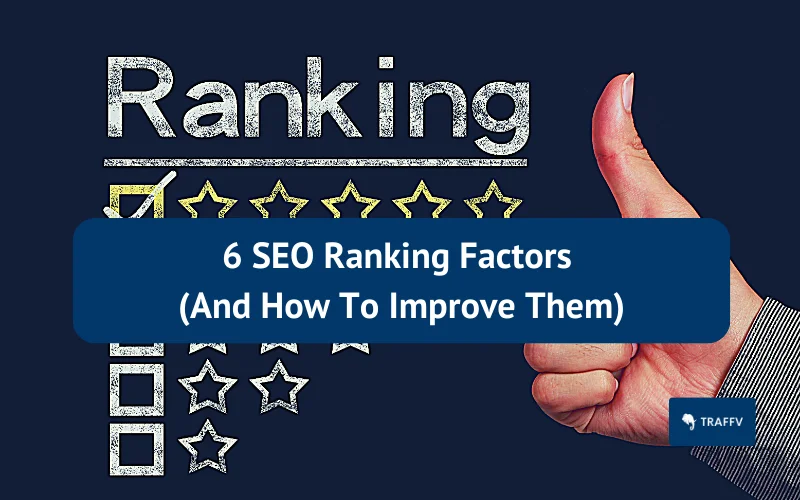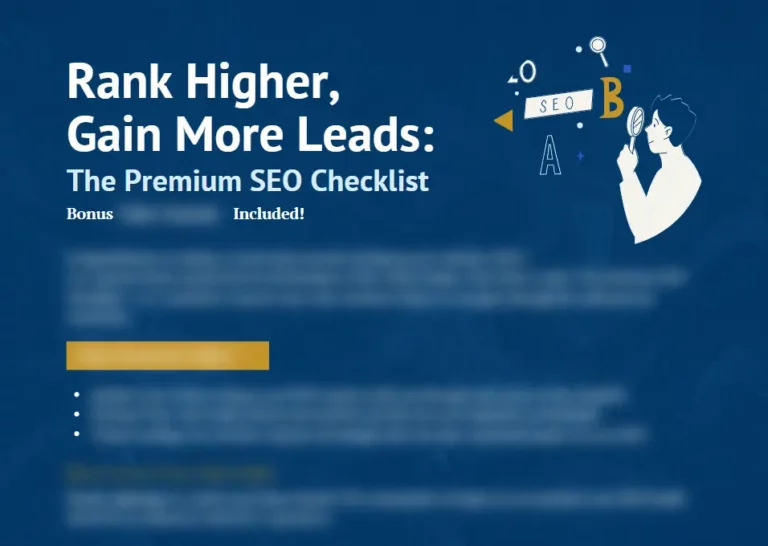As a digital compass navigating the vast ocean of online information, search engine optimization (SEO) is the guiding light that leads internet users to your digital shores.
A higher SEO ranking ensures your website’s visibility, attracting more organic traffic and increasing the potential for conversion.
But what elements influence your SEO ranking, and how can you optimize them for better results?
Let’s embark on this exploration of SEO ranking and its key factors together.
TL:DR
- Optimize website visibility and rankings with keyword research, high-quality content & E-A-T, backlinks, user experience & Core Web Vitals.
- Monitor SEO performance through tracking tools such as Google Search Console and Analytics.
- Utilize ongoing optimization to stay ahead in a constantly changing digital landscape.
What is SEO Ranking?
In the realm of digital marketing, search engine optimization ranking is a crucial element that determines the visibility of your webpage on search engine results pages (SERPs).
It’s like a digital billboard, the higher it is, the more visibility it gets, leading to increased organic traffic.
Search engines use a variety of elements, commonly referred to as SEO ranking factors, to determine the position of a webpage on the search engine results page.
It’s akin to a complex puzzle, where each piece plays a significant role in the final picture.
The ultimate goal of SEO as a marketing strategy is to attain higher search engine optimization rankings for keywords that can draw the right users and facilitate the growth of your business.
It’s like setting up signposts on the internet highway, guiding users to your business.
How Search Engines Rank Websites
Just as a librarian categorizes and organizes books, search engines, including Google and other search engines, are programs that crawl, index, and rank websites.
They use complex algorithms, such as Google’s algorithm, to evaluate websites based on factors such as relevance, quality, and user experience, ultimately determining the search results.
Just as a restaurant’s rating is influenced by factors such as food quality, service, and ambiance, search engines consider various factors when ranking websites.
These include relevance, quality, user experience, and more specific factors such as keyword research and targeting, high-quality content and E-A-T, backlinks, user experience and core web vitals, site structure and navigation, social signals and online reputation.
Understanding these google ranking factors is like having a blueprint for building a successful online presence.
Comprehending how search engines, especially Google, operate and evaluate websites is essential for attaining higher rankings.
Reports such as Site Search and User Flow in Google Analytics, as well as the Performance report in Google Search Console, can provide insights into what people are searching for.
Techniques such as conducting keyword research, creating high-quality content, building backlinks, optimizing user experience, and more can be employed to enhance SEO ranking.
Top 6 SEO Ranking Factors
Just as a master painter knows the importance of every brush stroke, understanding the key SEO ranking factors is imperative for successful website optimization.
The top six factors that significantly impact SEO rankings include keyword research and targeting, high-quality content and E-A-T, backlinks, user experience and Core Web Vitals, site structure and navigation, and social signals and online reputation.
Let’s delve into these six crucial areas.
1. Keyword Research and Targeting
Imagine you’re a fisherman.
The sea is the internet, your net is your website, and the fish are your potential customers.
Keyword research and targeting is like finding out what kind of bait attracts the type of fish you’re after.
It involves researching and selecting relevant keywords that individuals are likely to use when searching for content related to your website.
When selecting effective keywords, it’s essential to consider search intent, relevance to search queries, and search volume, much like a fisherman considers the type of fish, its preferred food, and the abundance of the species in the area.
Google’s complex algorithm takes into account the use of keywords on the page, including frequency and location, as well as the relevance of the surrounding text, when assessing the relevance of a webpage to a specific search query.
Search intent in keyword research, like understanding the behavior of the fish you’re targeting, is crucial.
Google gives significant consideration to the purpose behind each query and strives to deliver the most relevant results.
Keyword research is the compass guiding your content creation, helping search engines understand the context of keyword usage and ascertain the page’s relevance to the user’s inquiry.
2. High-Quality Content and E-A-T
In the digital landscape, content is king and quality is its crown.
High-quality content and E-A-T (Expertise, Authoritativeness, and Trustworthiness) are paramount for improving SEO rankings.
It’s like a restaurant serving gourmet meals – customers will keep coming back for the exceptional quality and trust the chef’s expertise.
The content of your web page should be comprehensible and easily accessible to both users and Google’s crawlers for efficient crawling and indexing.
Just as a restaurant’s reputation can be damaged by poor service, compromising user experience to please Google can lead to penalties.
Outbound links from your website to other authoritative sites can have a positive effect on SEO rankings by demonstrating that you are creating quality content and linking to relevant, authoritative sites in your niche.
3. Backlinks
Imagine your website is a candidate running for office, and backlinks are endorsements from reputable sources.
They can significantly impact your website’s credibility and SEO rankings.
Just as an endorsement from a respected figure can boost a candidate’s credibility, links from industry leaders, reputable media outlets, and bloggers can significantly impact SEO rankings.
These endorsements, in the SEO world, are part of what’s known as “off-page SEO”.
Obtaining backlinks organically is like earning genuine endorsements based on merit.
It’s a testament to the quality of your content and its relevance to your audience.
Deploying the right link-building strategy is like running a successful campaign, with the ultimate outcome being a trusted site including a relevant link to your content in their own.
4. User Experience and Core Web Vitals
Imagine walking into a beautifully designed store with items arranged neatly, clear signage, and helpful staff. This is akin to the user experience on a well-optimized website.
User experience and Core Web Vitals measure factors like page load speed, interactivity, and visual stability, contributing to overall user satisfaction.
Just as the layout and aesthetics of a store contribute to customer satisfaction, Core Web Vitals impact SEO rankings by influencing usability, page speed, and content, all of which contribute to the conversion rate.
Tools like Google’s mobile testing tool can assist in evaluating a website’s mobile page speed, ensuring optimal user experience.
Websites with slow loading times on mobile devices could be subject to penalties, much like a store with poor customer service could lose business.
Ensuring a positive user experience is like keeping your store tidy and welcoming, encouraging customers to stay longer and return.
5. Site Structure and Navigation
Imagine a library with a well-organized catalogue and clear signage, making it easy for you to find the book you’re looking for.
Similarly, a well-structured site with clear navigation aids both users and search engine crawlers in finding and accessing your content.
Just as a well-organized library allows patrons to find books effortlessly, a good internal link structure facilitates users and search engines to more easily locate pages on your website.
It’s like having a well-designed map for your website.
Ensuring that all parts of your website are accessible through internal links is like ensuring that every book in the library can be found in the catalogue.
It’s essential for providing an efficient and enjoyable user experience, leading to improved SEO rankings.
6. Social Signals and Online Reputation
In the digital age, word of mouth has evolved into likes, shares, and reviews.
Social signals and online reputation are like the digital version of community reputation, and they can indirectly influence SEO rankings.
Just as a restaurant’s popularity can increase through positive word of mouth, social shares can indicate to search engines that your content is valuable and relevant.
A study of 23 million shares uncovered a clear correlation between social shares and search engine ranking.
Establishing a social media presence, and facilitating the sharing of content on social media, is like hosting a popular event – it raises awareness and enhances your reputation.
However, it’s important to note that Google does not consider social shares as a direct ranking factor.
Monitoring and Improving Your SEO Rankings
Just as a successful business continually evaluates and adjusts its strategies, monitoring and improving your SEO rankings involves tracking your SEO metrics, making ongoing optimizations, and updating your content to maintain its relevance and value.
Let’s look into this in more detail.
Tracking Your SEO Performance
Tracking SEO performance is like keeping a detailed log of a ship’s voyage.
It involves using tools such as Google Search Console, Google Analytics, and other SEO softwares to measure rankings, traffic, and user engagement.
Tools like Semrush’s Position Tracking tool serve as your SEO compass, helping you monitor your rankings and navigate the vast ocean of the internet.
Google Search Console, akin to a ship’s radar, provides updates on your site’s performance, including speed.
Just as a ship’s log can provide a comprehensive overview of the voyage, the “Landscape” report of Semrush’s Position Tracking tool provides a comprehensive overview of your SEO performance, including progress, key metrics, and a ranking distribution chart.
Alerts in the tool can be configured to notify you of important changes in your SEO journey, much like a ship’s alarm system.
Ongoing Optimization and Updates
In the ever-evolving digital landscape, ongoing optimization and updates are as essential as keeping a ship shipshape for a long voyage.
SEO optimization involves techniques and strategies for improving website visibility and ranking in search engine results pages.
However, achieving higher rankings is not a one-time effort.
Just as a ship needs regular maintenance and updates to ensure it remains seaworthy, your SEO strategy needs regular reviews and tweaks for sustained and improved SEO rankings.
Techniques like keyword research and targeting, creating high-quality content, establishing backlinks, enhancing user experience and core web vitals, optimizing site structure and navigation, and leveraging social signals and online reputation can be employed to optimize your website.
It’s like having a skilled crew on board, each member contributing to the successful voyage of your website in the vast ocean of the internet.
Ranking Factors for Online Success
As we drop anchor on our voyage through the world of SEO rankings, we’ve navigated the importance of SEO ranking, how search engines rank websites, and the top six SEO ranking factors.
Employing SEO services is like having a seasoned navigator on board, guiding you with expert direction, resources, and tools to effectively improve your website’s SEO rankings and accomplish your online marketing objectives.
SEO is a journey, not a destination.
Keep your compass steady, your crew skilled, and your ship in shipshape, and you’re sure to enjoy smooth sailing in the vast ocean of the internet.
Frequently Asked Questions
What is SEO position ranking?
SEO ranking is a website’s position on the search engine results page, influenced by content relevance, quality of backlinks, and other factors.
It is essential for increasing visibility, traffic, and overall visibility online.
What does ongoing optimization and updates involve?
Ongoing optimization and updates involve regularly reviewing and adjusting your SEO strategy, updating content, and addressing any technical issues to ensure your rankings stay high.
This process requires ongoing attention and effort to ensure your website remains competitive and visible in the search engine results pages.




